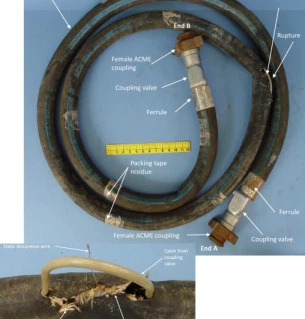 Dans les unités de traitement d’eau à haute pression, l’équipement et la tuyauterie sont fournis avec des brides à joint annulaire pour assurer joints sans fuite. La plupart de ces brides sont faites en acier inoxydable austénitique types 321SS ou 347SS. L’étude rapportée par Sciencedirect.com décrit l’analyse de défaillance de brides fissurées d’un four de chauffe placé devant le réacteur dans l’unité ISOMAX. Le matériau de la bride est un acier 321 SS. L’inspection visuelle, le ressuage, la microscopie optique et des tests EDS (spectroscopie à dispersion d’énergie) ont été utilisés pour cette analyse. Les résultats obtenus montrent que le mécanisme de fissuration trouve son origine dans une corrosion sous tension (SCC) en milieu chloruré. La source de chlorure est de la graisse anti-grippage qui est utilisée pour une étanchéité complète.
Dans les unités de traitement d’eau à haute pression, l’équipement et la tuyauterie sont fournis avec des brides à joint annulaire pour assurer joints sans fuite. La plupart de ces brides sont faites en acier inoxydable austénitique types 321SS ou 347SS. L’étude rapportée par Sciencedirect.com décrit l’analyse de défaillance de brides fissurées d’un four de chauffe placé devant le réacteur dans l’unité ISOMAX. Le matériau de la bride est un acier 321 SS. L’inspection visuelle, le ressuage, la microscopie optique et des tests EDS (spectroscopie à dispersion d’énergie) ont été utilisés pour cette analyse. Les résultats obtenus montrent que le mécanisme de fissuration trouve son origine dans une corrosion sous tension (SCC) en milieu chloruré. La source de chlorure est de la graisse anti-grippage qui est utilisée pour une étanchéité complète.
Archives mensuelles : mai 2013
Rupture brutale d’une vanne à bille de grandes dimensions

Failure Analysis of a Rubber Hose in Anhydrous Ammonia Service
In July 2009, a fiber-reinforced rubber hose ruptured while being used to transfer liquid ammonia from a cargo tank truck to a storage tank. The rupture released ammonia vapor that drifted across a highway and through a neighborhood. As a result, one person was fatally injured and seven others required medical treatment.
This case history presents the failure analysis of the ruptured fiber-reinforced rubber transfer hose and focuses on the techniques used in the investigation. In particular, this case demonstrates how fractography can be applied to reinforced rubber and how Fourier transform infrared spectroscopy can be used to determine ammonolysis failure of fiber-reinforcement polymers.
Hydrogen embrittlement failure of box-like link-plate

Evidences indicate that the failure of link-plate is due to hydrogen. The possible source for hydrogen was introduced during melting and casting process. A great number of non-metallic inclusions in the link-plate material acted as traps of hydrogen.
Via : http://www.sciencedirect.com/science/article/pii/S1350630713000617
A Case Study of an Ethylene Oxide Explosion in a Sterilization Facility
The authors present the lessons learned from this incident through their direct involvement with the incident investigation as well as a review of previous, similar incidents investigated by the United States Environmental Protection Agency (EPA). The root cause and contributory factors for this explosion are discussed and recommendations provided on how similar incidents might be avoided in the future. One of the authors serves on the NFPA committee responsible for publishing the standard on safe storage, handling and use of ethylene oxide, and the paper concludes with an regulatory and industry perspective on alternative designs and equipment that could have prevented the exp.
Elevator chain wheel shaft break analysis


A chain wheel shaft is made of normalized steel C45 without heat treatment of the surface. Due to dimensional nonconformity of composing elements of wedge assembly and due to soft shaft surface, at local indenting of the edge of the gear-wheel hub keyway, a small mechanical surface damage occurred on the shaft that resulted in a crack initiation. The outcome of its slow growth, induced by rotation and rather low dynamic tensile-compressive stresses is a final break of the shaft caused by material fatigue.
Failure Investigation of the Bucket Wheel Excavator Crawler Chain Link

Cas Concrets – trois cas de de corrosion
![]() Trois fiches synthétiques traitants de cas d’analyses de défaillances viennent d’être postées dans la Mécatech du Cetim. Il s’agit de cas de défaillance par corrosion survenus sur des corps creux : une marmite pour collectivité, un chauffe-eau électrique et un extincteur.
Trois fiches synthétiques traitants de cas d’analyses de défaillances viennent d’être postées dans la Mécatech du Cetim. Il s’agit de cas de défaillance par corrosion survenus sur des corps creux : une marmite pour collectivité, un chauffe-eau électrique et un extincteur.
Ces fiches d’analyse de défaillance avaient été publiées entre 1983 et 1986 dans la revue Cetim-information.
Accident de travail mortel au Canada : une flèche lumineuse mise en cause
Le signaleur a eu la tête coincée entre un panneau de support et la remorque de transport lorsque la flèche a basculé. L’homme de 38 ans retirait les balises de signalisation sur un chantier routier lorsque l’accident s’est produit. La conception même du panneau amovible expliquerait en partie le décès de l’employé de l’entreprise Signa Plus Québec. Pour lire l’article cliquez ici
Cas Concrets – piston, axe, arbre et membrane
![]() Quatre nouvelles fiches traitant de cas d’analyses de défaillances survenues en service ont été postées dans la Mécatech du Cetim : un piston de moule d’injection, un axe de pince de manutention, un arbre cannelé de réducteur et une membrane vibrante de système hydraulique.
Quatre nouvelles fiches traitant de cas d’analyses de défaillances survenues en service ont été postées dans la Mécatech du Cetim : un piston de moule d’injection, un axe de pince de manutention, un arbre cannelé de réducteur et une membrane vibrante de système hydraulique.
Ces fiches d’analyse de défaillance avaient été publiées entre 1984 et 1986 dans la revue Cetim-information.




